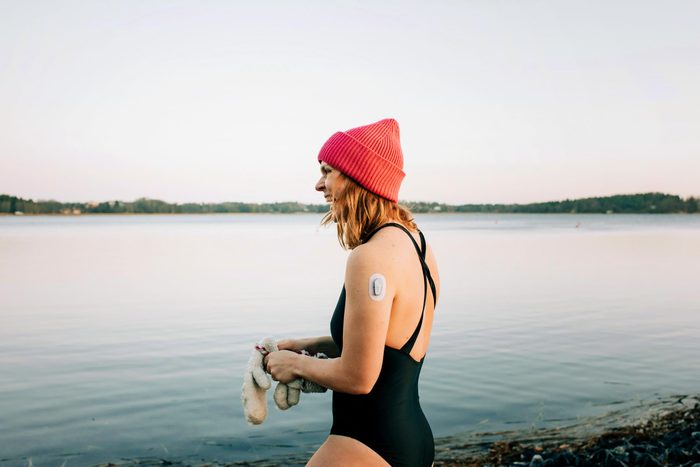Cold Plunging at This Time of Day May Help You Lose Weight, New Study Says
Updated: Jun. 21, 2023

Talk about a cool way to burn fat! A new study explores the links between cold-induced thermogenesis, metabolism, and your body clock.
If you’ve been following wellness trends, you’ve probably heard of cold water therapy. Also called “cold plunging,” this chilly choice has become increasingly popular among athletes seeking enhanced post-workout recovery to everyday individuals looking for non-pharmacologic relief from symptoms of depression, joint pain and inflammation. It seems clear that cold plunging offers a compelling health approach.
Now research suggests a frigid dip could help you lower another coveted metric. A recent study published in the Journal of Clinical Endocrinology and Metabolism says cold plunging at a certain time of day may support your metabolism.
Acupuncture to This Surprising Body Part May Help You Lose Weight, Says New Study
The science of cold-induced thermogenesis
Cold exposure is more than just a shiver-inducing experience. It mobilizes lipids, which most of us might think of as fat, to fuel the thermogenic processes in organs like brown adipose tissue (BAT). This is critical in maintaining body temperature. In rodents, brown adipose tissue metabolic activity shows a diurnal rhythm, peaking at the start of their wakeful period. Researchers set out to investigate whether this diurnal variation exists in humans too, and if it differs between men and women.
The study involved 24 young and lean male and female participants who underwent a 2.5-hour personalized cooling session in the morning and evening using water-perfused mattresses. The researchers measured their energy expenditure and supraclavicular skin temperature, a marker of BAT activity, in response to this cold exposure.
The body’s response to cold is more pronounced in the morning than in the evening for males, as indicated by energy expenditure and skin temperature over the collarbone. Females, on the other hand, show superior cold tolerance in the morning, able to reach a lower shivering threshold.
Not only that, but the study also found that levels of Free Fatty Acid (FFA)—a marker of fat breakdown and absorption by heat-producing tissues—rise more significantly in the morning than in the evening for both genders. Interestingly, other lipid biomarkers, including triglycerides, cholesterol, and high-density lipoprotein cholesterol (HDL-C), saw a greater morning increase, but this was exclusive to females.
Steve Aoki Just Dropped His #1 ‘Biohacking’ Secret
Timing your plunge for maximum benefit
Given the study’s findings, could the benefits of cold plunging also fluctuate depending on the time of day? And might they even differ between males and females?
While we still need direct research investigating this potential link, the idea is enticing. Understanding how our bodies respond to cold at different times of the day could help us maximize the benefits of cold plunging and other cold-exposure practices.
What Is Your ‘Set Point Weight’? Here’s How To Gauge It—And Why a Doctor Says You’ll Want To
Note of caution
While cold water immersion and thermogenesis have potential health benefits, they are not without risks. Cold shock—the initial shock from sudden exposure to cold water—can be dangerous, especially for those with cardiac conditions. Some studies suggest regular ice baths or winter swimming can reduce inflammation and cardiovascular risks. However, other research shows elevated troponin levels, indicating heart muscle damage, in winter swimmers. This prompted Dr. Jorge Plutzky, director of preventive cardiology at Brigham and Women’s Hospital in Boston, to caution against these cold therapy practices for anyone with a cardiac history via an American Heart Association News article.
The shock response can be lessened by gradually acclimating the body to colder water. Lee Hill, an exercise scientist at the Research Institute of the McGill University Health Centre in Quebec, recommends starting slowly, suggesting outdoor swimming before temperatures drop and continuing as it gets colder. If outdoor swimming isn’t feasible, he proposes taking increasingly cooler showers or baths at home and exercising outside.
While the benefits of cold water immersion and thermogenesis are promising, it’s essential to approach these practices with caution, particularly for those with pre-existing health conditions. As always, discuss with a healthcare professional before starting any new health regimen.
Can You ‘Reset’ Your Metabolism—and Are There Benefits Besides Weight Loss?
Moving forward
Dr. Mariëtte R. Boon, the study’s lead investigator, emphasized the practical implications of this research with Medical News Today. She suggested that, particularly for men, taking a morning cold shower might provide more benefits.
So, the next time you consider taking a cold plunge, you might want to factor in the clock. Our bodies are dynamic systems, and understanding the rhythms that govern our physiological responses can help us optimize our wellness routines. If you’re aiming to boost your energy expenditure or stimulate lipid metabolism (“fat burn”), a morning dip could be the way to go.
However, it’s important to remember that research in this area is ongoing. Further understanding is yet to be developed.
For the latest in health and wellness, get The Healthy @Reader’s Digest newsletter. Keep reading for more expert advice:
- Over 50? Using the Internet for This Long Each Day Could Reduce Dementia Risk, Says New Study
- Acupuncture to This Surprising Body Part May Help You Lose Weight, Says New Study
- What’s Your Sex IQ? Take This Quiz from a Doctor in Human Sexuality to Find Out
- This Is What a Dermatologist First Notices About You

















